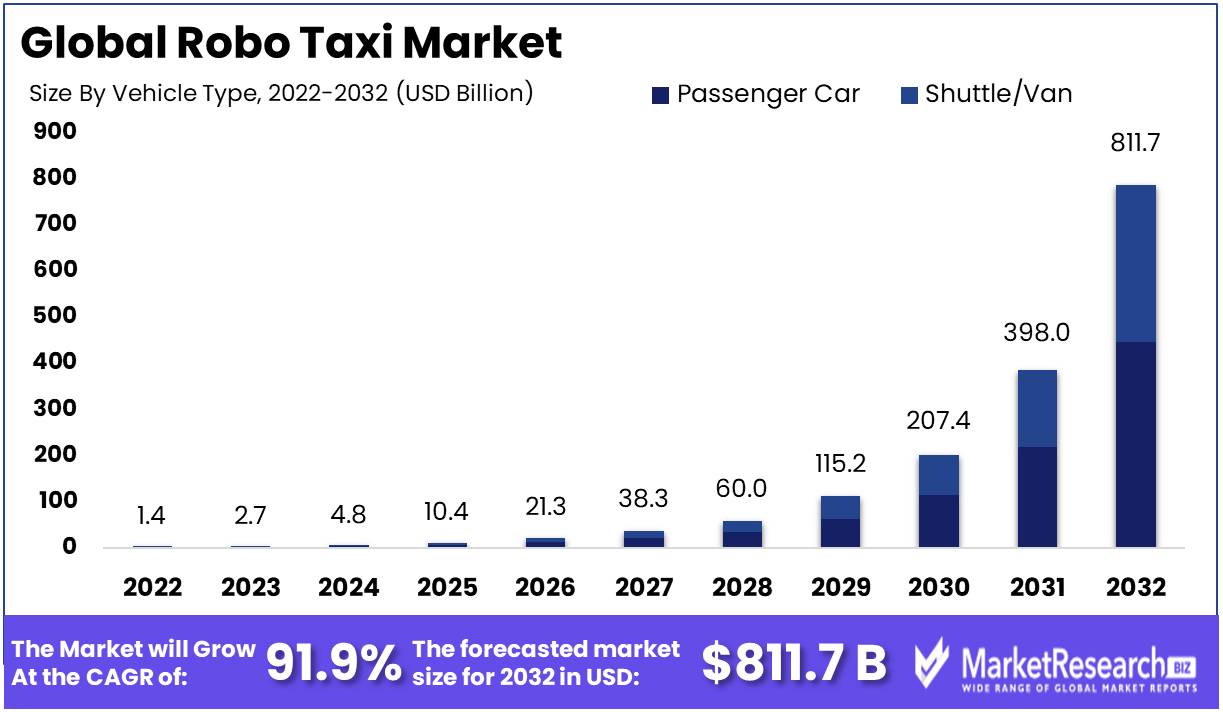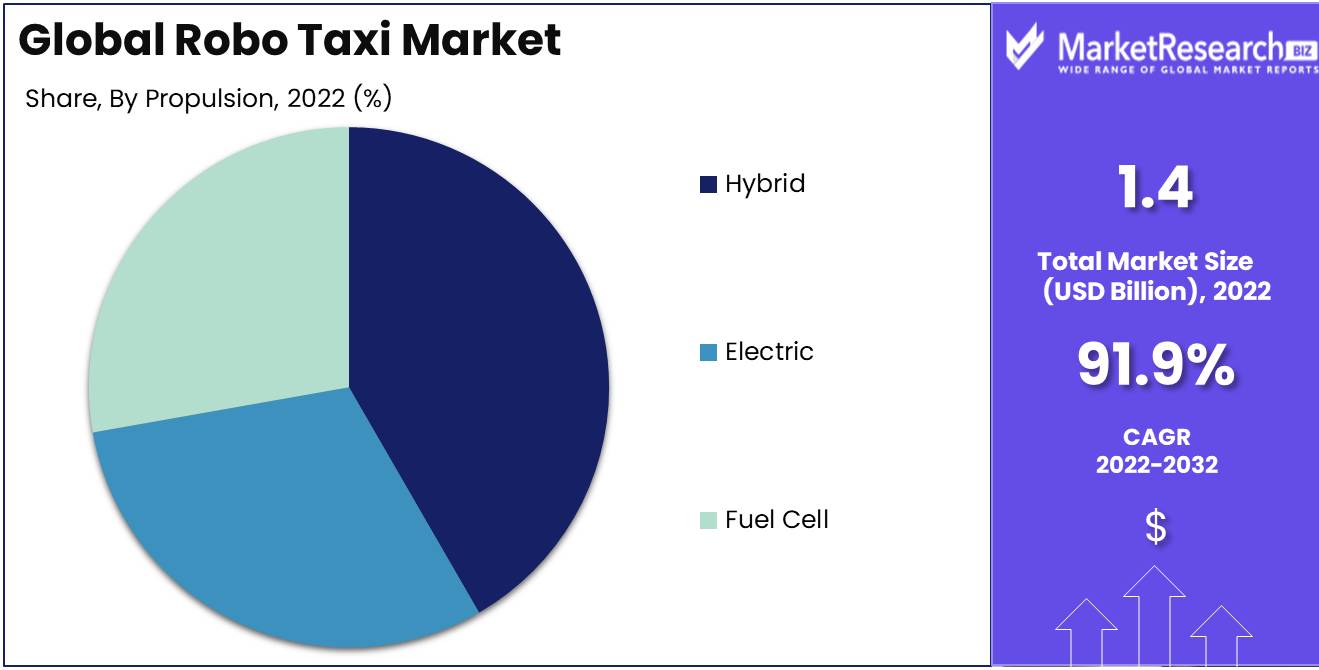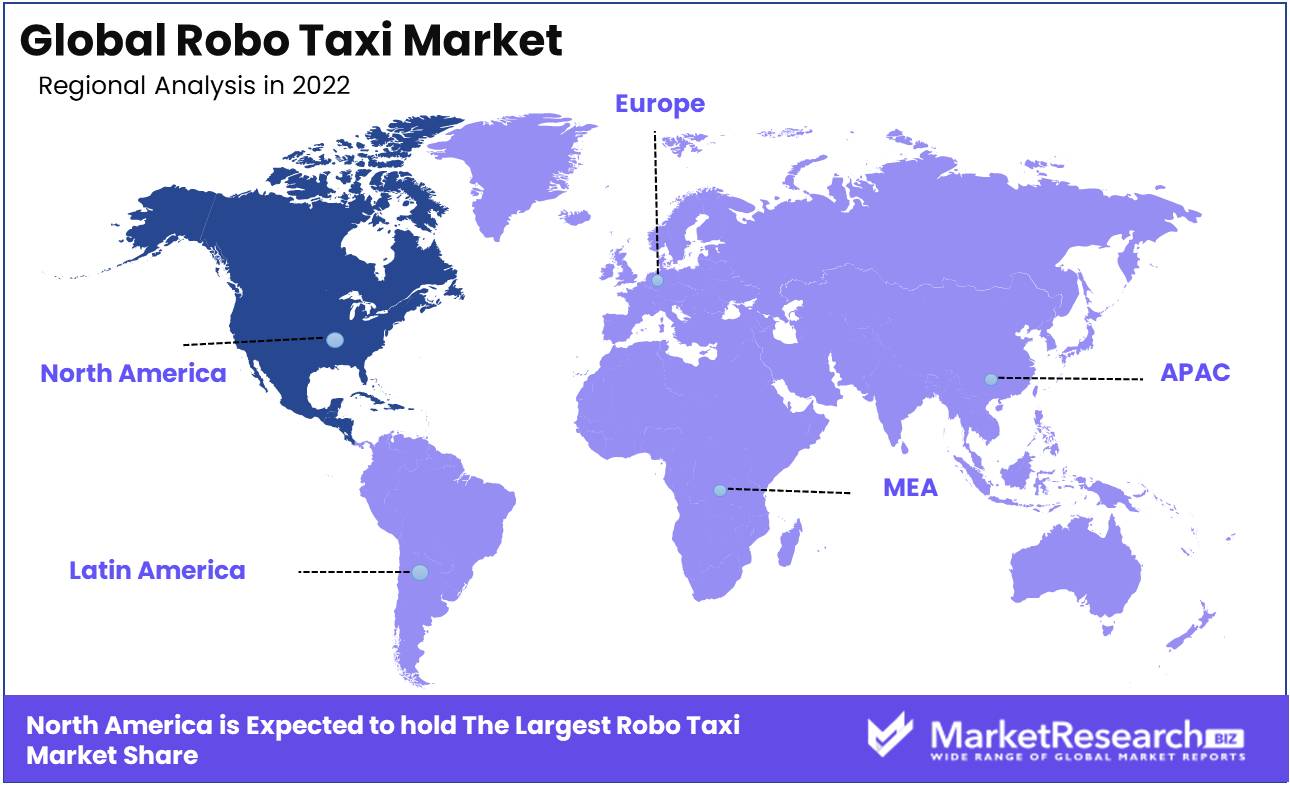
Robo Taxi Market By Vehicle Type (Passenger Car, Shuttle/Van), By Applications (Passenger Transport, Goods Transport), By Autonomy Level (L5, L4), By Propulsion (Hybrid, Electric, Fuel Cell), By Region And Companies - Industry Segment Outlook, Market Assessment, Competition Scenario, Trends, And Forecast 2023-2032
-
26446
-
June 2023
-
163
-
-
This report was compiled by Kalyani Khudsange Kalyani Khudsange is a Research Analyst at Prudour Pvt. Ltd. with 2.5 years of experience in market research and a strong technical background in Chemical Engineering and manufacturing. Correspondence Sr. Research Analyst Linkedin | Detailed Market research Methodology Our methodology involves a mix of primary research, including interviews with leading mental health experts, and secondary research from reputable medical journals and databases. View Detailed Methodology Page
-
Quick Navigation
Report Overview
Robo Taxi Market size is expected to be worth around USD 811.7 Bn by 2032 from USD 1.4 Bn in 2022, growing at a CAGR of 91.9% during the forecast period from 2023 to 2032.
The mysterious Robo Taxi Market tantalizes our senses to no end! Self-driving taxis, devoid of human drivers, navigate the turbulent currents of the asphalt jungle in a mesmerizing domain. Imagine intelligent vehicles outfitted with cutting-edge sensors, exquisite cameras, and other technological marvels deftly navigating through a labyrinth of traffic while transporting passengers to their desired destinations. An ethereal symphony of safety, dependability, and affordability plays out as this magnificent market strives to bestow upon the populace a mode of transportation that is unparalleled.

Such is the attraction of the Robo Taxi Market, a celestial catalyst destined to transform our urban commutes. Within its mystic depths is a profound transformation, an alchemical process that promises freedom from congestion, and an elixir that purifies the air we breathe. Without a doubt, it beckons those without the ability to drive, granting them access to the realms of mobility. The Robo Taxi Market, with its inherent capacity to prevent catastrophes caused by human error, harnesses a formidable force to quell our insatiable appetite for energy. To enjoy a stay in its domain is to luxuriate in the embrace of comfort and ease.
As the celestial clock marches forward inexorably, the Robo Taxi Market teems with vibrant innovations. Observe the emergence of awe-inspiring sentience as AI-powered autonomous systems spread their digital wings. These marvels, outfitted with sensors capable of deciphering the enigmatic dance of objects in complex environments, choreograph a ballet of awareness. Let us not neglect the cartographic masters, who wield their technological wizardry to navigate treacherous terrains and labyrinthine paths by the light of precision.
Indeed, the Robo Taxi Market is destined for exponential expansion, a rapid ascension comparable to the regal ascent of a phoenix. Companies from all over the world are responding to the clarion cry and venturing forth to invest their fortunes in this burgeoning industry. As the market expands, its expansive dominion will be subdivided into numerous applications, such as robotaxis, transports, ride-hailing services, and even car rentals. The crescendo of urban din reverberates, a clarion call for sustainable transportation systems that reverberates through the corridors of progress, energizing the ascension of the Robo Taxi Market.
The Robo Taxi Market derives its vitality from the very essence of human desire for a cost-effective, safe, and environmentally-friendly conveyance. Its meteoric rise is propelled by a trinity of forces: the escalating demand for cost-effective, secure, and environmentally friendly transportation alternatives; the march of progress in AI and self-driving technologies, with each leap spawning innovation; and the urgent need to quell the specters of traffic congestion and pollution that haunt our urban realms.
Driving Factors
Increasing Demand for Autonomous Vehicles and Ride Sharing Services
Due to the rising demand for autonomous vehicles and ride sharing services, the Robo Taxi market is experiencing significant growth. Consumers are pursuing cost-effective, eco-friendly, and convenient transportation options with on-demand options. This increasing demand has prompted private and public organizations to make substantial investments in the development of autonomous driving technology.
Advancements in Sensor and Mapping Technologies
The expansion of the Robo Taxi market is supported by developments in mapping and sensor technologies. Autonomous vehicles necessitate a robust infrastructure, which has been made possible by the development of these technologies. In addition, government support and favorable regulations encouraging the adoption of autonomous vehicles have fostered the growth of the industry.
Emphasis on Road Safety and Accident Reduction
The Robo Taxi market is driven primarily by improved road safety and accident reduction. Autonomous vehicles have the potential to substantially reduce collisions and improve road safety overall. As consumer preferences transition toward on-demand and convenient modes of transportation, the market continues to expand. Increasing awareness and adoption of electric vehicles and sustainable mobility solutions also contribute to its growth.
Restraining Factors
High Cost of Autonomous Driving Technology and Infrastructure Development
Costs associated with the development and production of autonomous driving technology and infrastructure continue to be a significant obstacle, impeding the widespread deployment of autonomous vehicles. The cost of autonomous technology research and development, including sensors and navigation systems, is still relatively high, rendering it prohibitive for many consumers and businesses. Moreover, the need for substantial investments in infrastructure such as 5G networks, electric vehicle charging systems, and advanced mapping technology to support autonomous vehicles exacerbates the difficulty of widespread adoption.
Consumers' lack of trust and confidence in autonomous driving technology
Consumers' lack of trust and confidence in the technology remains one of the most significant obstacles to the widespread adoption of autonomous vehicles. The perception that self-driving vehicles remain hazardous and unreliable contributes to the general reluctance to adopt autonomous technology. These concerns have been exacerbated by reports of accidents involving autonomous vehicles, making it difficult for consumers to completely trust and rely on the technology. This lack of consumer confidence in autonomous technology has resulted in low demand for autonomous vehicles, thereby impeding the Robo taxi market's growth.
Legal and Regulatory Challenges Surrounding Autonomous Vehicles and Liability Issues
Significant legal and regulatory obstacles hinder the deployment of autonomous vehicles, including policy gaps and a lack of a regulatory framework that can effectively regulate the operation of autonomous vehicles. The complex and variable laws on vehicle licensing, insurance, and registration, among others, pose a barrier to the widespread implementation of autonomous technology on our roads. In addition, the issue of liability in autonomous technology remains a significant obstacle, as the question of who is liable in the event of an accident involving an autonomous vehicle is not well-defined.
Vehicle Type Analysis
In the Robo Taxi Market, passenger cars are the most widely used vehicle class. The small to medium-sized platforms of these automobiles make them suitable for urban environments. Additionally, they are comparatively inexpensive, making them accessible to a greater number of consumers. Due to its adaptability and cost-effectiveness, the segment of passenger automobiles is anticipated to generate substantial revenue in the Robo Taxi Market.
The economic development of emerging economies drives the adoption of passenger vehicles in the Robo Taxi Market. Significant economic development is occurring in developing nations such as India, China, and Brazil, which is increasing the demand for affordable transportation. The Robo Taxi Market provides a cost-effective solution to the transportation requirements of these emerging economies, thereby driving the adoption of passenger cars in these countries.
The Robo Taxi Market consumer behavior toward passenger vehicles is driven by the need for affordability and convenience. Consumers favor the passenger car segment because it is less expensive than other vehicle categories. Moreover, passenger vehicles provide privacy and are comfortable for urban trips of short to medium length.
Service Type Analysis
The Service Type Analysis investigates the various types of Robo Taxi Market services. The market is dominated by various categories of services, each with its own advantages and disadvantages. In this section, we will examine the Robo Taxi Market's most popular service categories.
In the Robo Taxi Market, the Ride-Hailing Segment is the most prevalent service type. Ride-hailing is a prevalent mode of urban transportation designed for brief to medium-distance trips. The ride-hailing segment provides consumers with fast and convenient transportation options, making it a popular market segment.
The economic development of emerging economies drives the adoption of ride-hailing services within the Robo Taxi Market. Significant economic development is occurring in developing nations, which is increasing the demand for affordable transportation options. Ride-hailing services provide a cost-effective solution to the transportation requirements of these emerging economies, which is driving their adoption of this service type.
The demand for convenience and cost-effectiveness is driving consumer behavior in the ride-hailing segment of the Robo Taxi Market. Ride-hailing services provide affordable and convenient transportation options of superior quality. Using an app, consumers can easily reserve a ride without having to wait in lengthy lines or negotiate the fare with the driver.
Autonomy Level Analysis
In the Robo Taxi Market, Level 5 autonomy is the greatest level available. This degree of autonomy permits the vehicle to function without human intervention. Level 5 autonomy vehicles are equipped with sophisticated sensors and intelligent systems for safe urban navigation. Due to its high level of sophistication and dependability, the level 5 autonomy segment is anticipated to generate substantial revenue in the Robo Taxi Market.
The economic growth of emerging economies drives the Robo Taxi Market's adoption of level 5 autonomy vehicles. The level 5 autonomy segment provides an efficient and dependable high-tech transportation solution, making it suitable for urban areas. Significant economic development is occurring in developing nations, which is increasing demand for high-tech transportation solutions that can navigate complex urban environments.
In the Robo Taxi Market, the demand for sophisticated technology and dependability motivates consumer behavior toward level 5 autonomy vehicles. Level 5 autonomy vehicles are equipped with sophisticated sensors and intelligent systems for safe urban navigation. This segment attracts consumers because it offers dependable and sophisticated transportation solutions.
Propulsion Type Analysis
In the Robo Taxi Market, the Hybrid Vehicles Segment is the most prevalent propulsion type. Hybrid vehicles are engineered to utilize both an internal combustion engine and an electric motor. Hybrid vehicles can operate on electricity, making them environmentally friendly, and have a backup combustion engine for extended range. The adaptability of hybrid vehicles makes them popular on the market, as they can be utilized for a variety of trips.
The economic development of emerging economies drives the adoption of hybrid vehicles in the Robo Taxi Market. Significant economic development is occurring in developing nations, which is increasing the demand for eco-friendly transportation options. Because hybrid vehicles are environmentally favorable, they are in high demand in developing nations.
The demand for eco-friendly transportation solutions influences consumer attitudes toward hybrid vehicles on the Robo Taxi Market. The eco-friendliness of hybrid vehicles makes them an attractive option for consumers who care about the environment. Moreover, hybrid vehicles are flexible in that they can operate on both electricity and gasoline, making them an ideal option for a variety of journeys.

Key Market Segments
By Vehicle Type
- Passenger Car
- Shuttle/Van
By Applications
- Passenger Transport
- Goods Transport
By Components
- Camera
- LiDar
- Radar
- Ultrasonic Sensors
By Service Type
- Station-Based
- Car Rental
By Autonomy Level
- L5
- L4
By Propulsion
- Hybrid
- Electric
- Fuel Cell
Growth Opportunity
Recent Advancements in Autonomous Driving Technology
Technological advancements in autonomous driving, such as sensor and mapping systems, are one of the primary growth catalysts for the Robo Taxi market. These developments have increased the precision, dependability, and safety of autonomous vehicles. Consequently, people are more likely to trust and utilize autonomous ride-hailing services, resulting in a rise in demand. People's trust in this new mode of transportation is bolstered by the potential of autonomous driving technology to reduce human error, reduce travel expenses, and enhance road safety.
Growing Demand for Eco-Friendly and Sustainable Transportation Solutions
The increasing demand for eco-friendly and sustainable transportation solutions is another significant factor contributing to the growth potential of the Robo Taxi market. People around the world are concerned about the environment, and there is a growing demand for sustainable and eco-friendly transportation solutions. Autonomous ride-hailing services and shared mobility solutions provide a more sustainable mode of transportation and have the potential to substantially reduce transportation's carbon footprint. This is encouraging more individuals to adopt these autonomous vehicles, resulting in the Robo Taxi market's expansion.
Expansion of Ride Hailing and Car Sharing Services in Emerging Markets
In addition to the extension of ride-hailing and car-sharing services in emerging markets, the Robo Taxi market is expanding. In these markets, the demand for transportation solutions is increasing, and people are eager to adopt the new mode of transportation swiftly. Observing this trend, companies providing ride-hailing and car-sharing services in these emerging markets have begun to deploy substantial resources in these markets. Consequently, the Robo Taxi market is experiencing tremendous growth, with more autonomous ride-hailing services now available in these emerging markets.
Latest Trends
Collaborations and partnerships between automotive manufacturers and technology companies
No longer is the automotive industry comprised of traditional manufacturers competing to produce superior vehicles. Today, innovation in the automobile market is driven more by synergies and partnerships between traditional manufacturers and technology firms. Collaborations and partnerships offer an abundance of potential advantages, such as optimized resource utilization and shortened development cycles, which will ultimately result in cost savings and an enhanced in-vehicle experience.
The Growing Adoption of Electric and Hybrid Cars in Ride Hailing and Car Sharing Services
Ride-hailing and car-sharing services are growing in popularity, with the adoption of electric and hybrid vehicles fueling the expansion of these services. These services aim to reduce their carbon footprint by incorporating more environmentally responsible vehicles into their fleets. This trend is also transferring the emphasis from traditional automobile ownership to mobility as a service, which provides on-demand transportation at a reduced total cost of ownership.
Integration of Artificial Intelligence and Machine Learning in Autonomous Driving Systems
In autonomous transportation systems, the integration of artificial intelligence and machine learning is becoming increasingly crucial. These technologies enable autonomous vehicles to detect and avoid potential dangers, anticipate traffic conditions, and optimize travel routes. This enhanced level of safety and efficacy will drive the future adoption of autonomous technology.
Development of On Demand and Subscription Based Mobility Services
The transportation industry is undergoing a substantial transition from conventional ownership to a flexible and on-demand model. The emphasis is on providing transportation services on a subscription or pay-per-use basis, without the need for traditional vehicle ownership. This trend is causing an increase in, for example, on-demand ride-hailing services, electric scooters, and shared bicycles.
The Growing Focus on Passenger Safety and Security in Autonomous Ride-Hailing Services
The proliferation of autonomous ride-hailing services brings with it the duty to guarantee passenger safety and security. The industry of autonomous vehicles must provide solutions that ensure the safety and security of all consumers at all times. There are numerous ways to accomplish this objective, including the use of comprehensive cybersecurity features, multidimensional threat assessments, and remote monitoring.
Regional Analysis
The Robo Taxi market is dominated by North America, which is also home to several emerging firms that are revolutionizing numerous industries. Numerous incubators and accelerators support early-stage companies in the region, which has a flourishing entrepreneurial culture. This innovation-friendly environment attracts entrepreneurs and investors from around the globe.
Favorable government policies are an additional factor that has contributed to North America's Robo Taxi market dominance. The region is distinguished by a robust regulatory environment that encourages innovation and promotes growth. Governments in the region have been instrumental in fostering a business-friendly environment, making it simple for businesses to establish and expand their operations.
In addition to being proactive, the Canadian government has supported innovation and entrepreneurship. The country has one of the most robust startup ecosystems in the world, characterized by an abundance of accelerators, incubators, and venture capitalists. The Canadian government has made substantial investments in startup support, providing tax incentives, grants, and other forms of financial assistance.
On the other hand, Mexico has implemented a number of policies designed to attract foreign investors. The region's strategic location makes it an attractive location for businesses seeking to establish operations in the Americas. Additionally, the nation has implemented policies that encourage the growth of vital industries such as manufacturing and telecommunications.

Key Regions and Countries
North America
- US
- Canada
- Mexico
Western Europe
- Germany
- France
- The UK
- Spain
- Italy
- Portugal
- Ireland
- Austria
- Switzerland
- Benelux
- Nordic
- Rest of Western Europe
Eastern Europe
- Russia
- Poland
- The Czech Republic
- Greece
- Rest of Eastern Europe
APAC
- China
- Japan
- South Korea
- India
- Australia & New Zealand
- Indonesia
- Malaysia
- Philippines
- Singapore
- Thailand
- Vietnam
- Rest of APAC
Latin America
- Brazil
- Colombia
- Chile
- Argentina
- Costa Rica
- Rest of Latin America
Middle East & Africa
- Algeria
- Egypt
- Israel
- Kuwait
- Nigeria
- Saudi Arabia
- South Africa
- Turkey
- United Arab Emirates
- Rest of MEA
Key Players Analysis
Waymo, a subsidiary of Alphabet Inc. (formerly Google), is one of the leading Robo Taxi market competitors. Waymo, widely regarded as the leader in autonomous vehicle technology, has already launched its autonomous taxi service in Phoenix, Arizona. The company is also collaborating with automakers such as Chrysler and Jaguar Land Rover to provision their vehicles with its self-driving technology.
Cruise by General Motors is a significant competitor in the Robo Taxi market. The company has raised billions in funding and is currently testing autonomous vehicles in San Francisco. The company is also collaborating with Honda to develop autonomous vehicles for commercial use.
Uber, Tesla, and Baidu are also significant Robo Taxi market participants. Uber has spent years developing autonomous ride-hailing services and has already begun pilot testing in cities such as San Francisco and Pittsburgh. The Autopilot feature of Tesla's electric vehicles is a step toward autonomous ride-hailing services. And Baidu, China's most popular search engine, is making significant advances in self-driving technology.
Top Key Players in Robo Taxi Market
Recent Development
- In February 2022, Cruise LLC, a division of General Motors specializing in autonomous vehicles, launched a level 4 robo taxi service in San Francisco. Level 4 automation refers to a high level of autonomy in which a vehicle can operate autonomously in certain predefined conditions or locations. By offering robo taxis in San Francisco, Cruise made autonomous vehicles accessible to the public, allowing passengers to experience autonomous transportation firsthand.
- In July 2022, Baidu, Inc., a Chinese technology corporation, introduced its Apollo RT6 sixth-generation robo taxi. This vehicle was notable for being the first to be completely electric and without a steering column. The Apollo RT6 was created to facilitate completely autonomous driving, allowing passengers to travel without a driver.
- In September 2022, Waymo, a subsidiary of Alphabet Inc. (Google's parent company) specializing in autonomous vehicle development, announced that it would begin testing its robo-taxi service in Miami, Florida. This announcement indicated that Waymo was planning to introduce its autonomous ride-hailing service to the Miami area. The testing phase likely entailed collecting data, refining the technology, and assuring the safe and efficient operation of autonomous vehicles in the unique urban environment of Miami.
Report Scope
Report Features Description Market Value (2022) USD 1.4 Bn Forecast Revenue (2032) USD 811.7 Bn CAGR (2023-2032) 91.9% Base Year for Estimation 2022 Historic Period 2016-2022 Forecast Period 2023-2032 Report Coverage Revenue Forecast, Market Dynamics, COVID-19 Impact, Competitive Landscape, Recent Developments Segments Covered By Vehicle Type (Passenger Car, Shuttle/Van)
By Applications (Passenger Transport, Goods Transport)
By Components (Camera, LiDar, Radar, Ultrasonic Sensors)
By Service Type (Station-Based, Car Rental)
By Autonomy Level (L5, L4)
By Propulsion (Hybrid, Electric, Fuel Cell)Regional Analysis North America – The US, Canada, & Mexico; Western Europe – Germany, France, The UK, Spain, Italy, Portugal, Ireland, Austria, Switzerland, Benelux, Nordic, & Rest of Western Europe; Eastern Europe – Russia, Poland, The Czech Republic, Greece, & Rest of Eastern Europe; APAC – China, Japan, South Korea, India, Australia & New Zealand, Indonesia, Malaysia, Philippines, Singapore, Thailand, Vietnam, & Rest of APAC; Latin America – Brazil, Colombia, Chile, Argentina, Costa Rica, & Rest of Latin America; the Middle East & Africa – Algeria, Egypt, Israel, Kuwait, Nigeria, Saudi Arabia, South Africa, Turkey, United Arab Emirates, & Rest of MEA Competitive Landscape Aptiv, EasyMile, Waymo, NAVYA, Ridecell, GM Cruise, Uber Technologies Customization Scope Customization for segments, region/country-level will be provided. Moreover, additional customization can be done based on the requirements. Purchase Options We have three licenses to opt for Single User License, Multi-User License (Up to 5 Users), Corporate Use License (Unlimited User and Printable PDF) -




